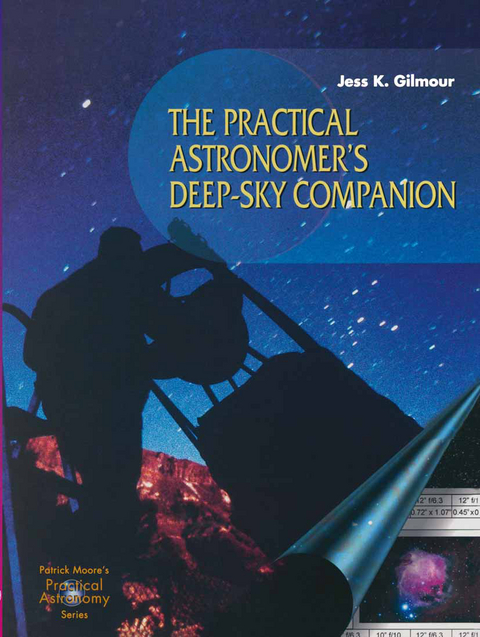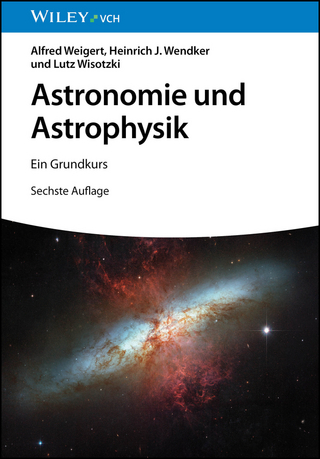
The Practical Astronomer’s Deep-sky Companion
Seiten
2002
Springer London Ltd (Verlag)
978-1-85233-474-1 (ISBN)
Springer London Ltd (Verlag)
978-1-85233-474-1 (ISBN)
As an amateur astronomer with years of experience, I marvel at the joy experienced by a beginner who successfully hunts down their first deep-space object in a telescope. . . . . . . . . . . . . . . . . . . . . . . . . Xl . . . . . . . . . . . . . . . . .4 Aquila ... . . . .
As an amateur astronomer with years of experience, I marvel at the joy experienced by a beginner who successfully hunts down their first deep-space object in a telescope. No matter what age or skill level, "nailing" a previously unobserved object through the eye piece, both instantly defines their love of the hobby and gives a feeling of scientific accomplishment no matter how well known to others the object may be. With the advancement in computer-guided telescopes and automatic object center ing, the amateur astronomy hobby has experienced tremendous and unprecedented growth. First timers are attending public observing sessions or summer star parties with low-cost computer-controlled telescopes, and are instantly rewarded with views of celes tial objects with strange names and numbers. But: what to look at? Can I see it through my telescope? For the seasoned observer the problem is different: "I've seen that object a thousand times, can anybody show me something new?" Astrophotographers, novice and seasoned, often wonder about capturing new objects on film or CCD, but first spend hours poring through star charts familiarizing themselves with the star field, selecting guide star, etc. The contents of this book combines, in a clear and concise manner, information that will assist beginner, novice, intermediate and advanced amateur astronomy hobbyists. The objects are all visible in medium-to-large-aperture telescopes and provide a wide selection of objects to observe or photograph. vii Contents Introduction. . . . . . . . . . . . . . . . . . . . . . . . . Xl . . . . . . . . . . . . . . . . Andromeda. · 1 Aquarius. .4 Aquila ... . · 7 Aries ..... . · 9 Auriga .... . 12 Bootes .... .
As an amateur astronomer with years of experience, I marvel at the joy experienced by a beginner who successfully hunts down their first deep-space object in a telescope. No matter what age or skill level, "nailing" a previously unobserved object through the eye piece, both instantly defines their love of the hobby and gives a feeling of scientific accomplishment no matter how well known to others the object may be. With the advancement in computer-guided telescopes and automatic object center ing, the amateur astronomy hobby has experienced tremendous and unprecedented growth. First timers are attending public observing sessions or summer star parties with low-cost computer-controlled telescopes, and are instantly rewarded with views of celes tial objects with strange names and numbers. But: what to look at? Can I see it through my telescope? For the seasoned observer the problem is different: "I've seen that object a thousand times, can anybody show me something new?" Astrophotographers, novice and seasoned, often wonder about capturing new objects on film or CCD, but first spend hours poring through star charts familiarizing themselves with the star field, selecting guide star, etc. The contents of this book combines, in a clear and concise manner, information that will assist beginner, novice, intermediate and advanced amateur astronomy hobbyists. The objects are all visible in medium-to-large-aperture telescopes and provide a wide selection of objects to observe or photograph. vii Contents Introduction. . . . . . . . . . . . . . . . . . . . . . . . . Xl . . . . . . . . . . . . . . . . Andromeda. · 1 Aquarius. .4 Aquila ... . · 7 Aries ..... . · 9 Auriga .... . 12 Bootes .... .
Andromeda.- Aquarius.- Aquila.- Aries.- Auriga.- Bootes.- Camelopardalis.- Cancer.- Canes Venatici.- Canis Major.- Capricornus.- Cassiopeia.- Cepheus.- Cetus.- Coma Berenices.- Corvus.- Cygnus.- Delphinus.- Draco.- Eridanus.- Gemini.- Hercules.- Leo.- Leo Minor.- Lepus.- Lynx.- Lyra.- Monoceros.- Ophiuchus.- Orion.- Pegasus.- Perseus.- Pisces.- Sagitta.- Sagittarius.- Scorpius.- Sculptor.- Scutum.- Serpens Caput.- Serpens Cauda.- Taurus.- Triangulum.- Ursa Major.- Virgo.- Vulpecula.
| Erscheint lt. Verlag | 31.10.2002 |
|---|---|
| Reihe/Serie | The Patrick Moore Practical Astronomy Series |
| Zusatzinfo | 155 Illustrations, color; 2 Illustrations, black and white; XIV, 146 p. 157 illus., 155 illus. in color. |
| Verlagsort | England |
| Sprache | englisch |
| Maße | 210 x 279 mm |
| Themenwelt | Sachbuch/Ratgeber ► Natur / Technik ► Weltraum / Astronomie |
| Naturwissenschaften ► Physik / Astronomie ► Astronomie / Astrophysik | |
| ISBN-10 | 1-85233-474-6 / 1852334746 |
| ISBN-13 | 978-1-85233-474-1 / 9781852334741 |
| Zustand | Neuware |
| Haben Sie eine Frage zum Produkt? |
Mehr entdecken
aus dem Bereich
aus dem Bereich
Perspektiven auf die Menschheit
Buch | Hardcover (2024)
Klett-Cotta (Verlag)
25,00 €
auf der Suche nach neuen Planeten und außerirdischem Leben
Buch | Hardcover (2024)
Droemer (Verlag)
24,00 €


